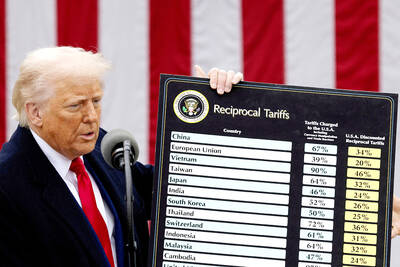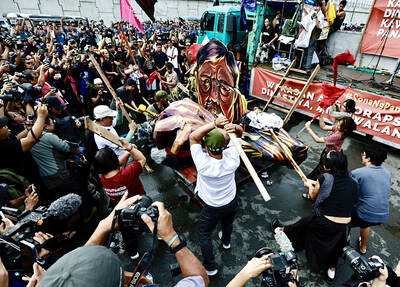Pushpa Bhatia is in a dilemma as she scans the glittering gold offerings laid out on a showcase at a fancy jewelry store in the Indian capital.
With the precious metal’s price on a roller-coaster ride, she is wondering whether she should buy now or wait.
“Will the price go up or down — you tell me,” the sari-clad Bhatia says to the salesman, who responds with a shrug.
Last week, gold posted its biggest weekly gain in a decade, climbing by 13 percent to US$864.70 an ounce, as mounting credit turmoil pushed investors into safe haven assets.
But Bhatia can’t wait too long — India’s marriage and festival seasons are approaching and she needs gold for both.
She has a 23-year-old daughter getting married in November and she likes to give small “auspicious” golden gifts for the Hindu calendar’s biggest holiday of Diwali, or the Festival of Lights, next month.
India is the world’s biggest gold consumer, importing 700 tonnes to 800 tonnes a year on average — about 30 percent of global demand.
And higher prices won’t stop Indians buying, said Suresh Hundia, head of the Bombay Bullion Association.
“Those who have marriage commitments will buy — no matter what the rates,” Hundia said.
Indian brides are traditionally bedecked in heavy gold jewelry — seen as a family heirloom and also security.
With about 10 million marriages a year in the country of 1.1 billion people, wedding-related demand is huge, especially during the nuptial season between October and January and April and May.
“The idea of giving gold to the bride is it will bail her and her family out in times of crisis,” said Ajay Mitra, managing director of the World Gold Council in India.
The gold given to a bride is known as streedhan, or “woman’s wealth.”
In fact, jewelry store salesman Devender Kumar said: “Most of the time the customers don’t even look at the design — they just look at the weight.”
However, lifestyles are changing in urban areas.
Bhatia’s daughter, Supriya, a newly minted accountant in tight trousers and an applique T-shirt, says she’s bored with the metal.
“It’s too heavy to put on,” she says, screwing her face in disgust at an elaborate gold chain the salesman is looping around her mother’s neck.
The vast array of consumer goods and trendy accessory jewelry to be found in India’s cities have made gold a less sought-after item for many.
“For thousands of years women had very little personal wealth other than their jewelry — they didn’t have bank accounts,” said Arvind Singhal, head of retail consulting firm Technopak.
“But now with the empowerment of women in urban areas, they want to spend their disposable income on cars, TVs, holidays, a new handbag,” Singhal said.
Still, bride-to-be Supriya Bhatia knows she won’t win the battle over her gold wedding jewelry as her mother orders her to sit and pay attention.
“It’s a necessity to own gold if you’re a woman,” her mother said firmly.
And even though urban tastes are changing, India’s overall gold consumption is unlikely to alter much in the foreseeable future, analysts say.
There is “a growing trend toward luxury goods rather than wanting to buy gold in urban areas,” said Suki Cooper, analyst at London’s Barclays Capital.
But she said “the majority of gold consumption is in rural areas,” where “that level of consumerism doesn’t exist so India is likely to stay a very important gold consuming nation.”
In the countryside, where the banking system is still poorly developed, gold rules as a medium of financial exchange and secure savings vehicle.
“Beyond the big cities, gold is something which has intrinsic value for consumers,” Mitra said. “They know they will never get cheated. It’s an insurance.”

Rainfall is expected to become more widespread and persistent across central and southern Taiwan over the next few days, with the effects of the weather patterns becoming most prominent between last night and tomorrow, the Central Weather Administration (CWA) said yesterday. Independent meteorologist Daniel Wu (吳德榮) said that based on the latest forecast models of the combination of a low-pressure system and southwesterly winds, rainfall and flooding are expected to continue in central and southern Taiwan from today to Sunday. The CWA also warned of flash floods, thunder and lightning, and strong gusts in these areas, as well as landslides and fallen

WAITING GAME: The US has so far only offered a ‘best rate tariff,’ which officials assume is about 15 percent, the same as Japan, a person familiar with the matter said Taiwan and the US have completed “technical consultations” regarding tariffs and a finalized rate is expected to be released soon, Executive Yuan spokeswoman Michelle Lee (李慧芝) told a news conference yesterday, as a 90-day pause on US President Donald Trump’s “reciprocal” tariffs is set to expire today. The two countries have reached a “certain degree of consensus” on issues such as tariffs, nontariff trade barriers, trade facilitation, supply chain resilience and economic security, Lee said. They also discussed opportunities for cooperation, investment and procurement, she said. A joint statement is still being negotiated and would be released once the US government has made

SOUTH CHINA SEA? The Philippine president spoke of adding more classrooms and power plants, while skipping tensions with China over disputed areas Philippine President Ferdinand Marcos Jr yesterday blasted “useless and crumbling” flood control projects in a state of the nation address that focused on domestic issues after a months-long feud with his vice president. Addressing a joint session of congress after days of rain that left at least 31 dead, Marcos repeated his recent warning that the nation faced a climate change-driven “new normal,” while pledging to investigate publicly funded projects that had failed. “Let’s not pretend, the people know that these projects can breed corruption. Kickbacks ... for the boys,” he said, citing houses that were “swept away” by the floods. “Someone has

‘CRUDE’: The potential countermeasure is in response to South Africa renaming Taiwan’s representative offices and the insistence that it move out of Pretoria Taiwan is considering banning exports of semiconductors to South Africa after the latter unilaterally downgraded and changed the names of Taiwan’s two representative offices, the Ministry of Foreign Affairs (MOFA) said yesterday. On Monday last week, the South African Department of International Relations and Cooperation unilaterally released a statement saying that, as of April 1, the Taipei Liaison Offices in Pretoria and Cape Town had been renamed the “Taipei Commercial Office in Johannesburg” and the “Taipei Commercial Office in Cape Town.” Citing UN General Assembly Resolution 2758, it said that South Africa “recognizes the People’s Republic of China (PRC) as the sole